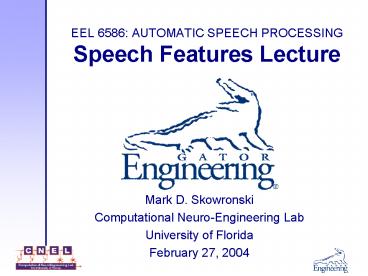EEL 6586: AUTOMATIC SPEECH PROCESSING Speech Features Lecture - PowerPoint PPT Presentation
1 / 16
Title:
EEL 6586: AUTOMATIC SPEECH PROCESSING Speech Features Lecture
Description:
Feature extraction allows for the addition of expert information into the solution. ... Hugs peaks of spectra. Computationally inexpensive ... – PowerPoint PPT presentation
Number of Views:95
Avg rating:3.0/5.0
Title: EEL 6586: AUTOMATIC SPEECH PROCESSING Speech Features Lecture
1
EEL 6586 AUTOMATIC SPEECH PROCESSINGSpeech
Features Lecture
- Mark D. Skowronski
- Computational Neuro-Engineering Lab
- University of Florida
- February 27, 2004
2
What are speech features?
- Speech features are
- A linear/nonlinear projection of raw speech,
- A compressed representation,
- Salient and succinct characteristics (for a given
application).
3
Why extract features?
- Applications
- Communications
- Automatic speech recognition
- Speaker identification/verification
Feature extraction allows for the addition of
expert information into the solution.
4
Application example
- Automatic speech recognition between two speech
utterances x(n) and y(n). - Naïve approach
Problems w/ this approach?
5
Naïve approach limitations
- x(n) -1y(n), yet E?0
- x(n) a y(n), yet E?0
- x(n) y(n-m), yet E?0
These variations can be removed by considering
the normalized magnitude spectrum
A feature vector of the raw speech signal!
6
Frequency domain features
The Fourier transform
- Then consider the Euclidean distance between
X(k) and Y(k)
What about pitch?
7
Pitch harmonics
- Pitch harmonics reduce overlap between spectra.
Can we remove pitch? How?
8
Pitch-free speech features
- Linear prediction (1967)
- Parametric estimator all-pole filter for vocal
tract model - Hugs peaks of spectra
- Computationally inexpensive
- Transformable to more stable domains (cepstrum,
reflection, pole pairs)
9
Pitch-free speech features
- Linear prediction (1967)
- Parameters sensitive to noise, numeric precision
- Doesnt model zeros in vocal tract transfer
function (nasals, additive noise) - Model order empirically determined
- Too low miss formants
- Too high represent pitch information
10
Pitch-free speech features
- Cepstrum (1962)
- Nonparametric estimator homomorphic filtering
transforms convolution to addition - Pitch removed by low-time liftering in quefrency
domain - Orthogonal outputs
- Cepstral mean subtraction (removes stationary
convolutive channel effects)
11
Pitch-free speech features
- Cepstrum (1962)
- Doesnt consider human auditory system
characteristics (critical bands) - Sensitive to outliers from log compression of
noisy spectrum (sum of the log approach)
12
Modern improvements
- Perceptual linear prediction (Hermansky,1990)
- Performs LP on the output of perceptually
motivated filter banks - Filter bank smoothes pitch (and noise)
- All the same benefits as LPC
- Mel frequency cepstral coefficients (Davis
Mermelstein, 1980) - Replace magnitude spectrum with mel-spaced filter
bank energy - Filter bank smoothes pitch (and noise)
- Orthogonal outputs (Gaussian modeling)
13
Modern improvements
- Human factor cepstral coefficients (Skowronski
Harris, 2002) - Decouples filter bandwidth from other filter
spacing - Sets bandwidth according to critical band
expressions for the human auditory system - Bandwidth may also be optimized to control
trade-off between local SNR and spectral
resolution
14
Other features
- Temporal features
- Static features (position)
- ? first derivative in time of each feature
(velocity) (1981) - ?? second derivative in time (acceleration)
(1981) - Cepstral Mean Subtraction (1974)
- Convolution constant ? Additive constant
- Removes static channel effects (microphone)
15
Typical feature matrix
Acceleration
Velocity
Position
Features
Time
16
References
- Auditory Toolbox for Matlab
- Malcolm Slaney, MFCC code
- http//rvl4.ecn.purdue.edu/malcolm/interval/1998-
010/ - HFCC and other Matlab tools
- blockX2.m change speech vector into column
matrix of overlapping windows of speech - fbInit.m create HFCC filter bank and DCT matrix
- getFeatures.m extract HFCC features
- http//www.cnel.ufl.edu/markskow/































